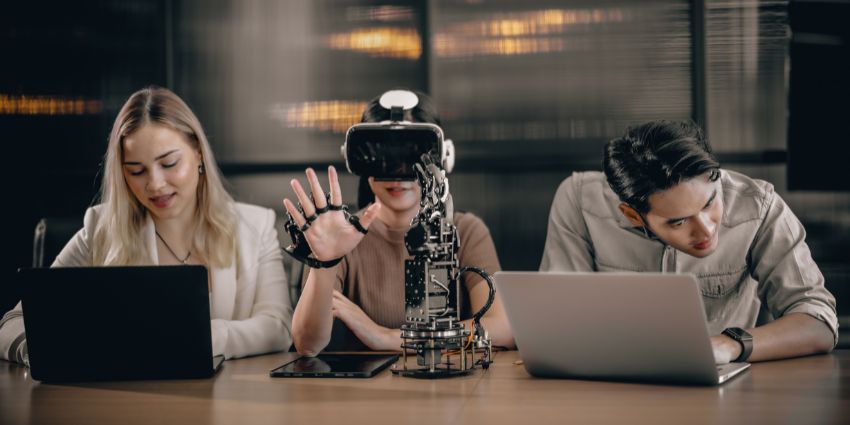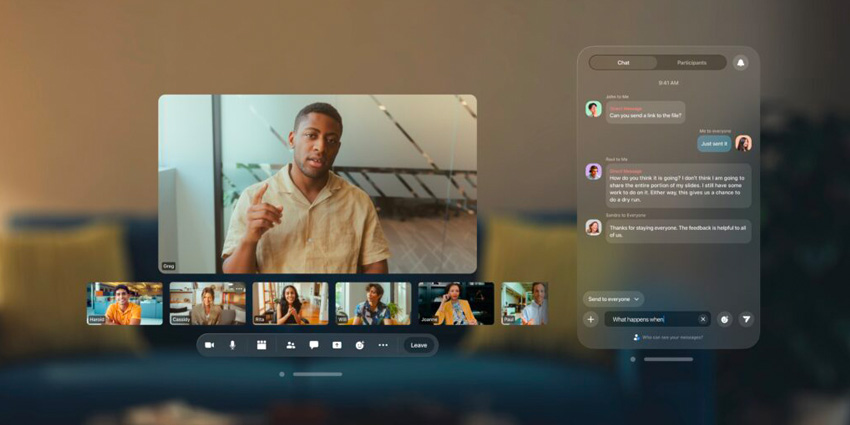Immersive technologies are no longer reserved for the gaming and entertainment industries. In recent years, as XR (Extended Reality) solutions have grown more advanced, we’ve begun to see these innovations appearing in virtually every enterprise and industry.
Driven by a need to synchronise employees in the world of hybrid and remote work, immersive collaboration is entering the mainstream. With a combination of VR, AR, and MR tools, businesses can unify staff like never before, enhance company culture, and even accelerate production processes.
Today, we’re looking at some of the most significant trends influencing the rise of the immersive collaboration landscape in 2023. Here’s what businesses can expect if they begin branching into the XR world for collaboration and communication in the years ahead.
1. VR Headsets Enter the Enterprise Tech Stack
As the standard office workplace evolves, and employees embrace the concept of “anywhere work”, we’ve seen countless new pieces of technology become essential to the modern technology stack. Cameras, room conferencing kits, and immersive displays have all become increasingly common. Now it seems that VR headsets, specifically made for the enterprise will become a key part of many modern business environments.
Virtual Reality has the potential to transform collaboration in a host of different ways, providing employees with the opportunity to represent themselves in a digital space and connect with others using hyper-realistic avatars. VR solutions can make workplaces feel less isolating, improving unity and presence in a distributed workplace. In fact, 60% of employees say they want their companies to invest in VR headsets by 2024, and 62% say they want to experience VR spaces and avatars.
VR solutions can also be an excellent way to boost productivity in the workplace, particularly as new software solutions emerge to allow companies to create powerful digital twins of their environments, products, and tools. These digital twins support teams in working together effectively on realistic versions of items and blueprints, allowing for rapid ideation and discovery.
2. XR and Artificial Intelligence Join Forces
Like Extended Reality, Artificial Intelligence has become a common component of the modern workforce in recent years. Many organisations today are relying more heavily on AI solutions in the form of analytical tools, virtual assistants, and even chatbots utilizing generative AI. Evolutions in the AI landscape are likely to have a significant impact on the way collaborating teams experience immersive reality going forward.
First, generative AI tools with large language models will empower companies without significant experience in the XR world to create more immersive visual assets and spaces for their employees to leverage in XR, AR, and VR applications. Secondly, AI tools built into software applications will allow teams to communicate more effectively with their apps. Many AI systems can use speech and gesture recognition software to improve the way we interact with digital assets.
AI solutions can improve the quality of communication between distributed teams, offering access to automatic translation tools, transcription features, and specialist technology to reduce the risk of misunderstandings among employees.
3. Mixed Reality Surges into the Mainstream
Though VR and AR technologies have gained significant steam in the enterprise and business landscapes over the last couple of years, mixed reality has been lagging behind. However, this could be about to change, as more developers work on the creation of mixed reality smart glasses and headsets, specifically designed for the enterprise.
Even the newer enterprise-focused Oculus Quest headset from Meta offers access to mixed reality elements, to help businesses combine the virtual and physical worlds. Ongoing investment into the MR space will lead to the development of ever-more impressive tools. Some solutions can already create holographic images of people and resources to help boost collaborative sessions.
Enhanced sensors, devices, and screens in the mixed reality world will help businesses to unlock the power of a unified environment, where digital and real-world solutions can come together in unison. However, it’s worth noting that these mixed-reality headsets and devices may be slightly more expensive to access than their VR and AR counterparts during the initial years of development. Despite this, we’re already beginning to see healthcare, manufacturing, and engineering companies all experimenting with mixed reality opportunities.
4. The Evolution of the Metaverse Office
As we progress towards the “future of work”, countless companies have been forced to rethink how they structure the workplace for today’s employees. With hybrid and remote employees located all over the world, physical spaces no longer serve as the best environment for collaboration. Fortunately, the rise of the metaverse in the XR world could provide a solution.
Increasingly, developers are building metaverse ecosystems which allow companies to build their own intuitive digital worlds, specifically intended to serve the needs of their employees. Many leading businesses have already explored this industry, with companies like Accenture producing the “Nth floor”, featuring replicas of real-world environments where employees can train and collaborate.
As solutions like generative AI and no-code and low-code platforms emerge to make metaverse environments more accessible, we’re likely to see an increase in the number of companies building their own virtual worlds. Used correctly, these landscapes could lead to an increase in diversity, equity, and inclusion throughout modern teams, while helping to ensure staff members can work effectively together, wherever they are.
5. XR Paves the Way for Global Inclusion
One of the biggest challenges business leaders face in the modern workplace, is finding ways to bring teams together to form stronger bonds when they’re distributed among different locations. Extended reality has already begun to offer solutions to this issue, with virtual reality environments for team work, AR-enhanced collaboration apps, and mixed reality.
However, developers are increasingly working on making the environment more accessible and inclusive. Today’s leading vendors of software allow team members to access virtual environments and tools using a range of devices, from web-based and mobile phone applications to wearable headsets produced by a host of different vendors. This could help businesses to ensure every team member can get involved in XR meetings and conversations.
At the same time, innovators in the XR space are also looking for ways to leverage the latest connectivity technology, such as 5G and edge computing, to help reduce the impact XR tools have on business bandwidth. Solutions like the Varjo cloud and other streaming solutions make it easier for businesses to deliver high-quality collaborative experiences, without investing in the most expensive computing systems and data centres.







